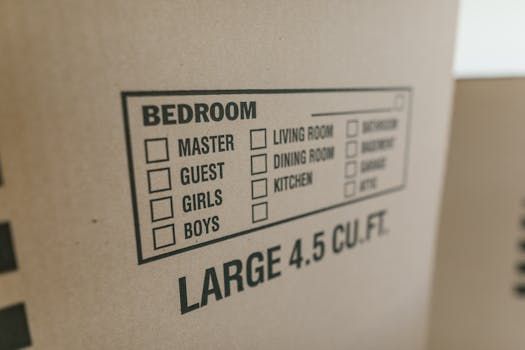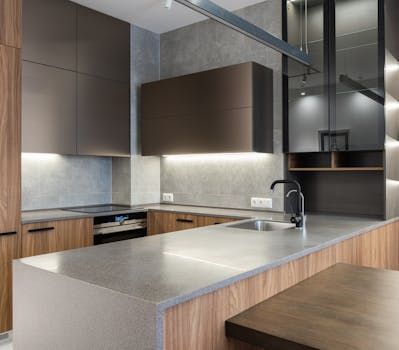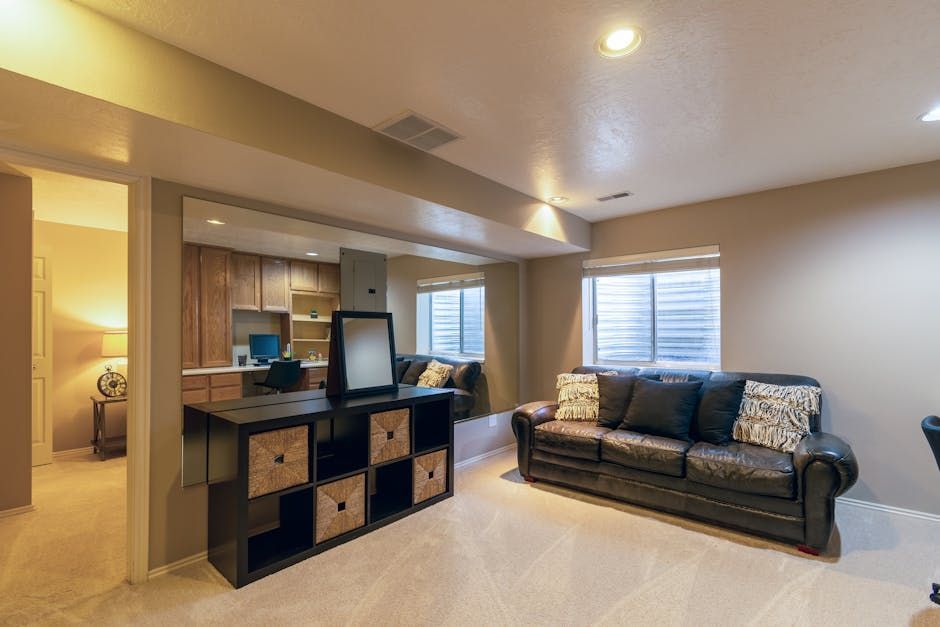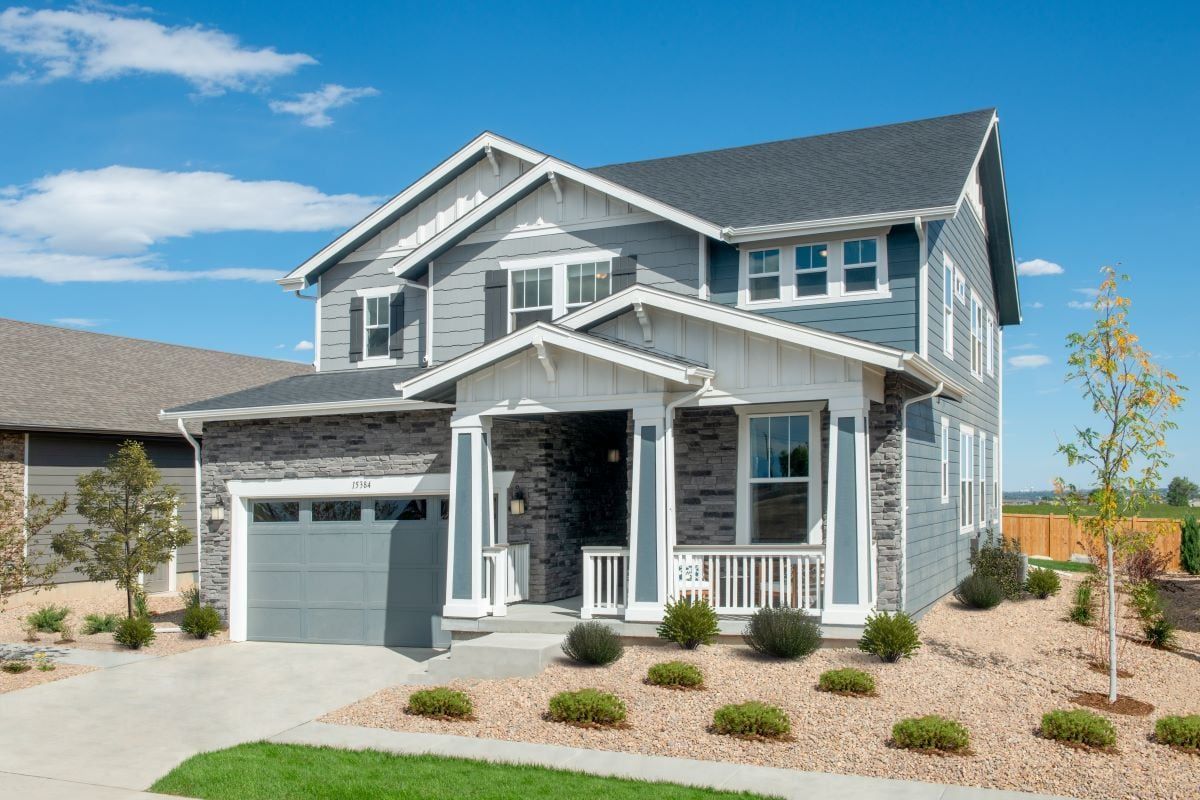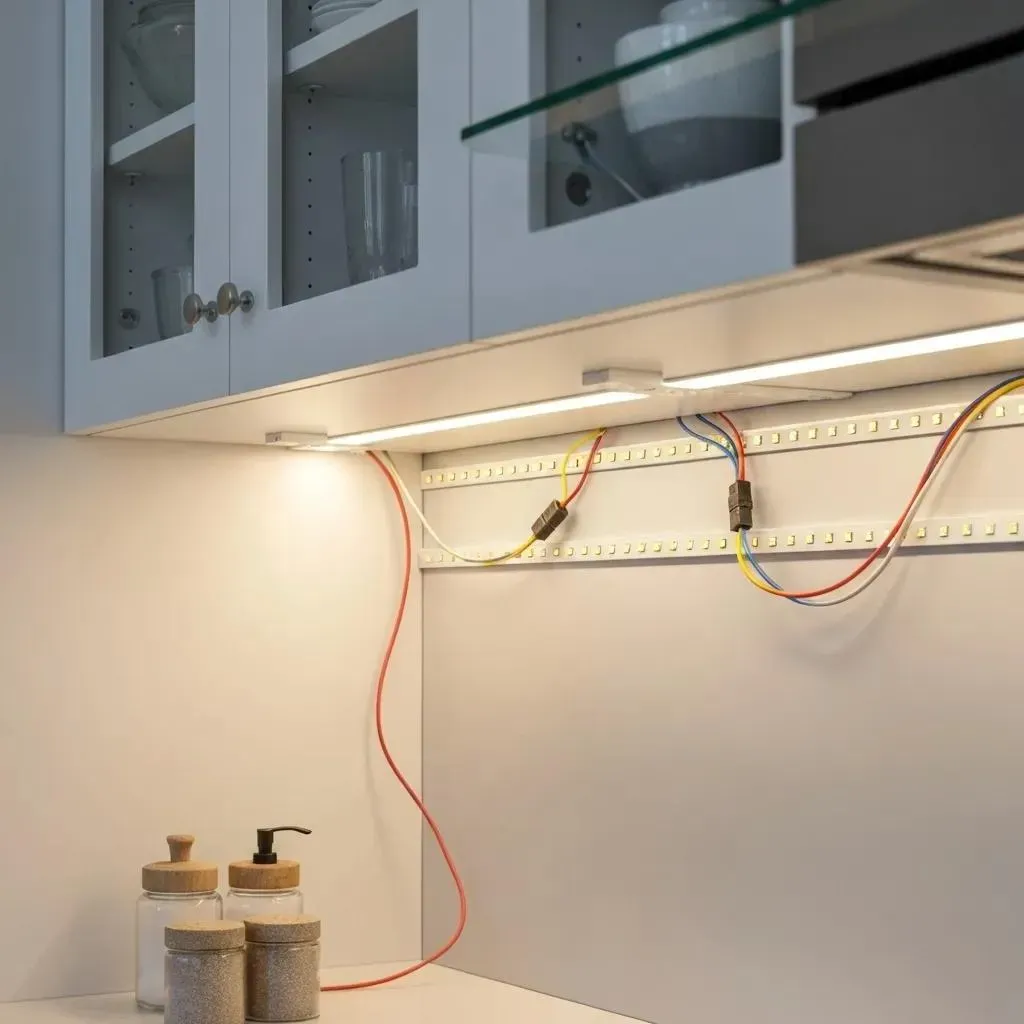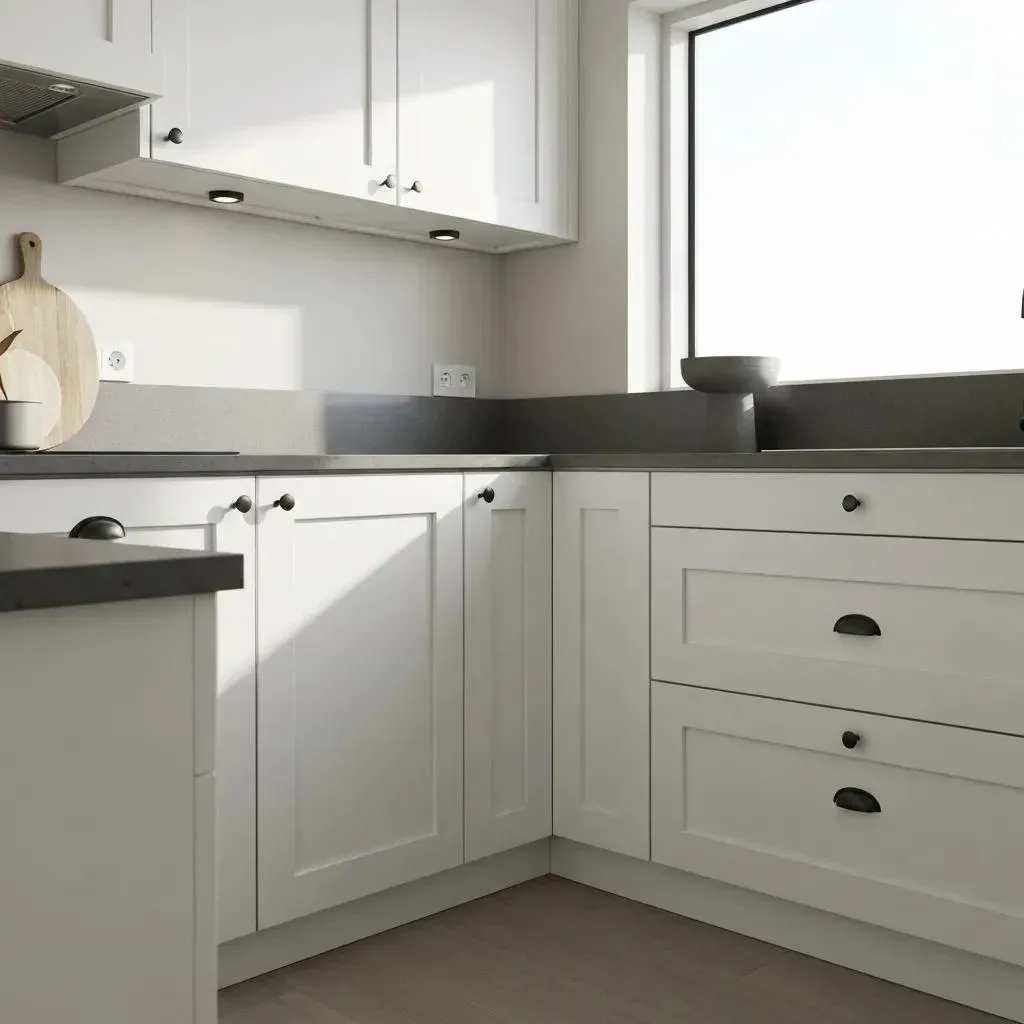The Price Tag of Custom Kitchen Cabinets: What to Expect
Understanding Custom Kitchen Cabinet Investment: Your Complete Cost Guide
How much do custom kitchen cabinets cost is one of the first questions Denver homeowners ask when planning their dream kitchen remodel. The answer isn't simple, but here's what you need to know upfront:
Quick Cost Overview:
- National Average: $7,473 (range: $2,807–$12,980)
- Per Linear Foot: $500–$1,200 installed
- Standard Kitchen (20 linear feet): $10,000–$24,000
- Large Kitchen (40 linear feet): $20,000–$48,000
- High-End Projects: Can exceed $30,000+
Custom cabinets cost significantly more than stock options ($100–$400 per linear foot) or semi-custom ($150–$700 per linear foot), but they offer best personalization and typically deliver a 70%+ return on investment.
The final price depends on several key factors: your choice of materials (MDF at $300–$400 per linear foot vs. cherry at $500–$700), kitchen size, design complexity, hardware quality, and local labor rates. In Denver's market, you'll also need to factor in delivery logistics and installation complexity.
As Mike Martinez from Accountable Home Remodeling, I've guided countless Denver homeowners through the custom cabinet investment process, helping them understand exactly how much do custom kitchen cabinets cost and how to maximize their budget. My 15+ years in kitchen remodeling has taught me that transparent pricing and realistic expectations are the foundation of every successful project.
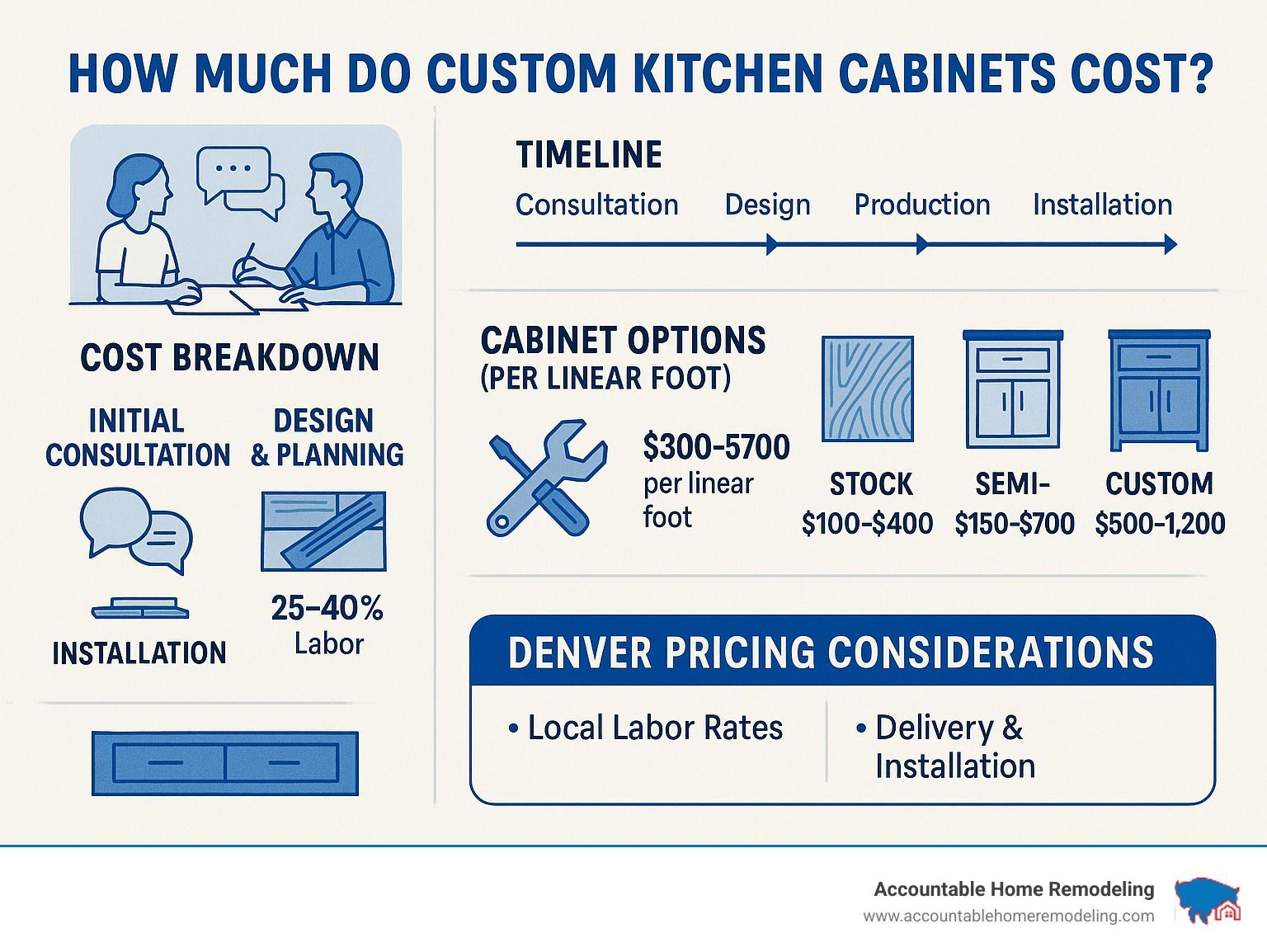
How Much Do Custom Kitchen Cabinets Cost in 2025?
Let's get straight to the numbers that matter. How much do custom kitchen cabinets cost in today's market? The national average has climbed to $7,473 for a complete project, but here in Denver, I see most homeowners investing between $15,000 and $30,000 for their dream kitchen.
The price range is wide for good reason. Custom cabinets aren't a one-size-fits-all product. Your final cost depends on everything from the wood species you choose to how complex your design gets. I've installed simple custom kitchens for $10,000 and luxury projects that topped $60,000.
According to the latest Bureau of Labor Statistics data, skilled cabinetmakers and installers in our Denver metro area earn between $70-$175 per hour. This directly impacts your project cost since labor typically represents 25-40% of your total investment. The good news? You're paying for genuine craftsmanship that shows in every detail.
Here's how custom cabinets stack up against other options:
Stock
$100-$400
$2,000-$8,000
Limited
Semi-Custom
$150-$700
$3,000-$14,000
Moderate
Custom
$500-$1,200
$10,000-$24,000
Complete
High-End Custom
$1,200-$2,000+
$24,000-$40,000+
Luxury
The jump from semi-custom to custom might seem steep, but here's what you're getting: complete control over every dimension, unlimited design options, and premium materials that aren't available in factory lines. Plus, custom cabinets fit your space perfectly—no awkward gaps or compromises.
Average Cost per Linear Foot Explained
When I quote how much do custom kitchen cabinets cost per linear foot, I'm measuring the bottom edge of your wall and base cabinets combined. Think of it as the "footprint" your cabinets occupy along your walls.
The typical breakdown looks like this: materials eat up $300-$900 per linear foot (about 60-75% of your cost), while labor and installation adds another $200-$450 per linear foot. Don't forget hardware and accessories—those soft-close hinges and pull-out drawers add $50-$200 per linear foot, but they're worth every penny.
Why such a wide price range? It all comes down to materials. MDF cabinets with laminate finishes start around $300-$400 per linear foot for materials alone. Step up to solid maple and you're looking at $400-$500 per linear foot. Choose exotic hardwoods like cherry or walnut, and materials can hit $500-$700 per linear foot before we even talk installation.
The beauty of custom work is that you can mix and match to fit your budget. Maybe you splurge on solid wood for your island but choose a quality veneer for the perimeter cabinets. It's your kitchen, your rules.
Total Price for a Standard Kitchen—how much do custom kitchen cabinets cost?
Let me paint a picture with real numbers from projects I've completed around Denver. These totals include materials, labor, and standard hardware:
For a standard 20 linear foot kitchen (think typical ranch home), you're looking at $10,000-$14,000 for basic custom cabinets with quality construction. Step up to mid-range custom with better wood species and upgraded hardware, and you'll invest $15,000-$20,000. Want the full luxury treatment? High-end custom projects in this size range hit $24,000-$30,000.
Got a larger 40 linear foot kitchen? Double those numbers. Basic custom runs $20,000-$28,000, mid-range climbs to $30,000-$40,000, and high-end projects can reach $48,000-$60,000 or more.
Here's the part that makes homeowners smile: custom cabinets typically deliver a 70%+ return on investment. In Denver's strong real estate market—especially in areas like Boulder, Lakewood, and central Denver—I often see even higher returns. Your kitchen isn't just a place to cook; it's an investment in your home's future value.
Key Factors That Drive Custom Cabinet Pricing
When Denver homeowners ask me "how much do custom kitchen cabinets cost," I always explain that it's like asking the price of a car—the answer depends entirely on what you're looking for. After helping hundreds of families through this process, I've learned that understanding these cost drivers upfront saves everyone time, money, and frustration.
Material selection is your biggest cost driver, hands down. Think of it as choosing between a Honda and a Mercedes—both will get you where you're going, but the experience and price tag are worlds apart. We work with everything from budget-friendly MDF to premium hardwoods, and I've seen material choices alone swing project costs by $15,000 or more.
Kitchen size and layout might seem obvious, but it's more nuanced than simple multiplication. A galley kitchen with 20 linear feet of cabinets costs far less than an L-shaped kitchen with the same footage because of corner cabinets, filler pieces, and installation complexity. Those tricky angles and specialty storage solutions can add 20-30% to your base cost.
Design complexity is where things get interesting. Basic box cabinets with simple doors keep costs reasonable, but add crown molding, custom storage solutions, integrated appliance panels, or multiple wood species, and you're looking at premium pricing. I always tell clients that every custom detail adds both beauty and cost—the key is choosing which details matter most to your family.
Hardware quality makes a bigger difference than most people realize. Basic hinges and pulls might cost $20-$50 per door, while premium soft-close systems with designer hardware can run $100-$200+ per door. In a 20-cabinet kitchen, that's potentially a $3,000+ difference just in hardware.
Regional labor rates and logistics also play a role. Here in Denver, we're competitive with national averages, but areas like Boulder command premium rates due to higher living costs and skilled labor demand. Delivery logistics matter too—getting cabinets to a downtown Denver high-rise costs more than a suburban ranch home.
Material Matters: MDF vs Maple vs Cherry
Choosing the right material is like picking the foundation for your entire kitchen. I guide families through this decision by focusing on three key factors: durability, appearance, and cost per linear foot. There's no "wrong" choice, just different priorities.
MDF (Medium Density Fiberboard) runs $300-$400 per linear foot and gets unfairly dismissed by some homeowners. The truth? It's fantastic for painted cabinets because it creates an incredibly smooth finish without visible grain. I recommend MDF for contemporary designs and families who want a crisp, clean look without the premium price tag. The downside is durability—it's not as tough as hardwood and can swell if it gets wet repeatedly.
Maple sits in that sweet spot at $300-$400 per linear foot, offering excellent durability with a consistent, workable grain. It's the workhorse of cabinet woods—reliable, versatile, and perfect for both staining and painting. Families with kids who are rough on cabinets love maple because it stands up to daily abuse. The only complaint I hear is that some find the grain pattern too subtle for their taste.
Cherry commands $500-$700 per linear foot, and for good reason. It's absolutely gorgeous with rich grain patterns that develop a beautiful patina over time. But here's what I always warn clients about: cherry darkens significantly as it ages. That light, honey-colored wood you fell in love with will become deep, reddish-brown within a few years. Some love this aging process; others are shocked by the change.
We also work with birch ($300-$400 per linear foot) for budget-conscious projects and white oak ($400-$600 per linear foot) for clients wanting that trendy, modern farmhouse look. For the truly adventurous, exotic species create stunning focal points but come with premium pricing.
Labor & Installation: What You Pay For
When homeowners see labor costs representing 25-40% of their total investment, I understand the sticker shock. But here's what that investment actually buys you: peace of mind and professional expertise that ensures your cabinets function perfectly for decades.
According to Harvard's Joint Center for Housing Studies expenditure data, skilled installation is crucial for long-term satisfaction. I've seen too many DIY disasters and cut-rate installations that looked fine initially but failed within years.
Your labor investment covers shop fabrication time—typically 40-80 hours for an average kitchen where skilled craftsmen cut, assemble, and finish every piece to exact specifications. Then comes precise on-site fitting, because custom cabinets are built to your exact measurements, not standard sizes that might "close enough."
Demolition and prep work often surprises homeowners. Removing old cabinets sounds simple until you find outdated electrical, plumbing issues, or walls that aren't square. Specialized installation requires years of experience to ensure perfect alignment, proper support, and smooth operation of every door and drawer.
In Denver, skilled cabinet installers charge $70-$175 per hour, which reflects the specialized nature of their work. While this seems high, proper installation ensures your investment lasts 20-25 years with minimal maintenance. I always remind clients: you can't afford cheap installation when you're investing this much in quality cabinets.
The quality control process includes multiple inspections, adjustments, and fine-tuning that separates professional installation from amateur work. This attention to detail is why our custom cabinet projects still function beautifully years later, while shortcuts often lead to costly repairs down the road.
Breaking Down Additional & Hidden Expenses
When homeowners ask how much do custom kitchen cabinets cost, they're often thinking about the cabinets themselves. But here's the thing—the cabinet price is just one part of your total investment. I've learned that being upfront about these additional costs helps families budget realistically and avoid those unpleasant surprises that can derail a project.
Demolition and disposal typically runs $300-$800, depending on what we're removing. If you have old cabinets that are built into the walls or extensive tile work to remove, expect to be on the higher end. We handle all disposal responsibly, which is included in this cost. Trust me, you don't want to deal with hauling old cabinets to the dump yourself.
Delivery and logistics add another $200-$600 to your project. This covers getting your beautiful new cabinets from our shop to your kitchen safely. If you live in a high-rise with elevator restrictions or have narrow staircases, we'll need extra time and crew members. I've seen too many cabinets damaged during delivery because corners were cut here.
Permits and inspections range from $100-$500, depending on your project scope. If we're moving walls, adding electrical for under-cabinet lighting, or relocating plumbing, permits are required. While it's tempting to skip this step, proper permits protect your investment and ensure everything meets code.
Designer fees typically run $100-$250 per hour for professional layout optimization. Many clients find this investment pays for itself through better space utilization and avoiding costly mistakes. A good designer can often save you money by suggesting efficient layouts that require fewer cabinets.
Timeline overruns happen, which is why I always recommend budgeting a 10-20% buffer. Material delays, unexpected structural issues, or change orders during construction can extend timelines and costs. It's better to plan for this possibility than scramble for extra funds mid-project.
For more detailed information about our comprehensive approach, visit our Kitchen Cabinet Remodeling Near Me page.
Popular Upgrades & Their Price Tags
Most of our clients find they want functional upgrades once they see their new kitchen taking shape. These aren't just nice-to-haves—they're investments in daily convenience that you'll appreciate every time you cook.
Pull-out drawers and organizers cost $150-$400 per cabinet but transform how you use your kitchen. Spice rack pull-outs ($200-$500) bring everything to eye level, while lazy Susans for corners ($200-$600) make those awkward spaces actually useful. Trash and recycling pull-outs ($300-$500) hide unsightly bins while keeping them easily accessible.
Soft-close hardware adds $20-$50 per door and drawer, but it's one of those upgrades clients never regret. No more slamming doors, no more catching your fingers, and the premium feel it adds to your kitchen is noticeable every single day. Plus, it actually extends your cabinet life by reducing wear and tear.
Glass front doors run $100-$300 per door and create beautiful display opportunities for your favorite dishes or glassware. They make kitchens feel more open and spacious, especially in smaller spaces. We offer clear, frosted, or textured glass depending on your style preferences.
Under-cabinet lighting costs $150-$400 per linear foot but dramatically improves both function and ambiance. LED strips or puck lights eliminate shadows on your countertops while adding that warm, inviting glow that makes your kitchen feel like the heart of your home.
Crown molding and trim at $15-$25 per linear foot gives your cabinets that finished, built-in look that screams quality. It covers any gaps at the ceiling and can be done in matching wood or a contrasting color for visual interest.
How Schedule & Region Affect the Final Bill—how much do custom kitchen cabinets cost pinpointed to your ZIP
Living in the Denver metro area, I've noticed significant cost variations depending on where exactly you're located. It's not just about the cabinets—it's about the logistics of getting the job done in your specific neighborhood.
Urban areas like Denver and Boulder typically see a 10-20% premium on projects. Higher labor costs are part of it, but the real challenge is often logistics. Narrow streets, limited parking, and apartment building restrictions all add complexity. Plus, homeowners in these areas often have higher expectations for materials and finishes.
Suburban areas like Broomfield, Westminster, and Thornton tend to hit our standard pricing. Easy access for delivery trucks, plenty of parking for our crew, and straightforward installation conditions keep costs predictable. These areas offer the sweet spot of quality work at fair prices.
Timing your project can also impact how much do custom kitchen cabinets cost. Peak season during spring and summer means standard pricing but longer lead times—sometimes 12-16 weeks instead of 8-10. Off-season projects in fall and winter might save you 5-10% and get faster scheduling, but holiday periods can carry premium pricing due to limited crew availability.
The key is planning ahead. If you're flexible on timing, we can often find ways to optimize both cost and schedule to work in your favor.
Smart Ways to Save Without Sacrificing Quality

Here's the truth: you don't have to break the bank to get beautiful custom cabinets. After helping hundreds of Denver families steer their kitchen remodels, I've learned that smart homeowners can significantly reduce how much do custom kitchen cabinets cost without sacrificing the quality or style they want.
The secret is knowing where to splurge and where to save. Think of it like buying a great suit—you invest in quality tailoring where it shows most, but you don't need silk lining that nobody sees.
The mix-and-match strategy is one of my favorites. We use custom cabinets for your kitchen's "starring roles"—the island everyone gathers around, the range wall that catches every eye—then pair them with high-quality semi-custom cabinets for the supporting cast. This approach typically saves 20-30% while maintaining that custom look where it matters most.
Open shelving integration offers another smart savings opportunity. Replacing some upper cabinets with floating shelves saves $200-$400 per linear foot while creating that airy, modern feel that's so popular right now. Plus, it's a great way to display your favorite dishes or that collection of vintage cookbooks.
One of the cleverest approaches we use is stock boxes with custom door fronts. We source quality cabinet boxes from trusted manufacturers, then craft custom doors and drawer fronts to match your vision perfectly. This hybrid approach can cut costs by 30-40% while still achieving that completely custom appearance.
Timing your project strategically can also impact your bottom line. Schedule during our slower periods—late fall through early spring—and you might find potential savings plus faster completion times. It's like booking a vacation during off-peak season, but for your kitchen.
For more creative ways to maximize your cabinet investment, explore our Customize Kitchen Cabinets services where we specialize in finding that perfect balance between your dreams and your budget.
DIY vs Hiring a Pro: Pros, Cons & Cost
I get asked about DIY cabinet building at least once a week, and I always give the same honest answer: it depends on your skills, available time, and tolerance for risk.
Going the DIY route can potentially save you 50-70% on labor costs, which sounds amazing until you consider what's involved. You'll need advanced woodworking skills, precision measuring abilities that would make a Swiss watchmaker proud, and finishing expertise. The time commitment is substantial—expect 100-200 hours for an average kitchen, which translates to several months of weekends and evenings.
Then there's the tool investment. Quality cabinet-making requires specialized equipment that can easily cost $2,000-$5,000. Unless you're planning to start a side business, that's a significant upfront expense that eats into your savings.
The biggest risk? Measurement errors and poor fit. Custom cabinets require precision down to 1/16 of an inch. One mistake can cascade into expensive material waste and frustration that makes strong people weep.
Professional installation, while representing an investment of $200-$450 per linear foot for labor, brings peace of mind that's hard to put a price on. We complete most installations in 1-2 weeks versus the 2-3 months most DIYers need. Plus, you get warranty protection and professional problem-solving when unexpected issues arise—and trust me, they always do.
For custom cabinets specifically, I strongly recommend professional installation. The precision required and potential for costly mistakes make it one of those times when hiring a pro is actually the smart financial choice.
Money-Saving Design Hacks
Some of the best money-saving strategies happen during the design phase, before a single board is cut. These aren't corners we're cutting—they're smart choices that often result in better kitchens.
Function-first layout design is my number one recommendation. When we design around how you actually cook and move through your kitchen, rather than chasing the latest trends, we often end up with simpler, less expensive configurations that work infinitely better for daily life.
Limiting specialty finishes to focal areas creates visual impact without premium costs throughout the entire kitchen. Choose one gorgeous finish for your island or range wall, then use standard finishes elsewhere. Your eye will be drawn to the special area, making the whole kitchen feel luxurious.
Reusing quality hardware is an often-overlooked opportunity. If your existing cabinet hardware is high-quality and fits your new style direction, we can often incorporate it into the new design. This simple choice can save $500-$1,500 while adding character and continuity.
Standard sizing is another smart strategy. When we design around standard cabinet dimensions rather than custom sizing every single piece, individual cabinet costs stay reasonable. Custom sizing typically adds 20-40% to each cabinet's price, so we reserve it for areas where it truly makes a difference.
The goal isn't to cheap out—it's to be strategic about where your dollars make the biggest impact on both function and beauty.
Planning, Measuring & Choosing a Cabinet Maker
Getting your custom cabinet project right starts with careful planning and choosing the right partner. I've seen too many homeowners rush this stage, only to face expensive corrections later. When you're investing thousands in custom cabinets, every detail matters.
Accurate measurements form the foundation of your entire project. We use laser measuring tools and create detailed CAD drawings because even a quarter-inch error can mean cabinets that don't fit properly. I remember one project where a previous contractor's measurement mistake cost the homeowner an extra $3,000 in modifications.
Understanding workflow zones is just as important as measurements. We study how you actually use your kitchen—where you prep, cook, and clean—to optimize cabinet placement and storage solutions. This isn't just about aesthetics; it's about making your daily life easier.
The timeline for custom cabinets typically runs 8-16 weeks from design to completion. This might seem long, but quality custom work can't be rushed. We coordinate this timeline with other trades like electricians and plumbers to minimize disruption to your daily routine.
Vetting your cabinet maker's credentials protects your investment. Look for licensed, insured contractors with proven experience in custom work. Check references and ask to see completed projects similar to yours. A reputable contractor will gladly share this information.
Itemized contracts prevent surprises and misunderstandings. Your agreement should spell out exactly what materials you're getting, how much labor is included, and when each phase will be completed. This transparency helps you understand exactly how much do custom kitchen cabinets cost for your specific project.
For design inspiration and planning help, visit our Kitchen Design Ideas page where you'll find examples of successful projects and layout options.
Timeline: From Design to Installation
Understanding the custom cabinet timeline helps you plan around your daily life and coordinate with other home improvement projects. Here's what actually happens during those 8-16 weeks.
Weeks 1-2 focus on consultation and design. We meet with you to understand your needs, take precise measurements, and develop your layout. This is when we discuss materials, finishes, and special features. We also provide detailed pricing so you know exactly what your investment covers.
Weeks 3-4 involve contract finalization and fabrication startup. Once you approve the final design and sign the contract, we order materials and begin the fabrication process. This is also when we coordinate scheduling with any other trades working on your project.
Weeks 8-12 are the fabrication completion phase. Your cabinets are being built, finished, and going through quality control. We handle delivery scheduling and make sure your kitchen is ready for installation. Any necessary demolition of existing cabinets happens during this window.
Weeks 13-14 bring the exciting installation phase. Our team delivers and installs your new cabinets, ensuring perfect fit and function. We install all hardware, make final adjustments, and complete our quality inspection with a detailed punch list.
Weeks 15-16 wrap up project completion. We conduct a final walkthrough with you, provide warranty documentation, and give you maintenance instructions. You'll have our contact information for any questions or service needs.
What to Look For in a Custom Cabinet Quote
A professional quote tells you everything you need to know about your project and protects you from surprises. After reviewing thousands of cabinet quotes over the years, I know what separates good contractors from great ones.
Detailed scope of work should specify exact cabinet quantities, sizes, and configurations. The quote should list material grades, wood species, and finish types. Hardware specifications matter too—you want to know if you're getting basic hinges or premium soft-close systems.
Itemized pricing breaks down materials costs, labor hours and rates, and any additional fees. This transparency helps you understand where your money goes and makes it easier to adjust the project if needed. Look for separate line items for permit and disposal fees as well as delivery and setup costs.
Project timeline should include fabrication lead time, installation schedule, and completion date. Good contractors also coordinate with other trades if you're doing a full kitchen remodel. This prevents delays and ensures smooth project flow.
Warranty terms protect your investment long-term. Material defect coverage should last at least one year, while installation warranty typically covers our workmanship for two years. Hardware warranty varies by manufacturer but should be clearly stated.
Payment schedule should tie payments to project milestones, not arbitrary dates. Expect to pay a deposit of 25-50% to start fabrication, progress payments as work completes, and final payment only when you're completely satisfied. Legitimate contractors provide lien waiver documentation to protect your property.
Frequently Asked Questions about Custom Cabinet Costs
When Denver homeowners start exploring custom cabinets, three questions come up in almost every conversation. Let me share the honest answers based on my 15+ years helping families steer these decisions.
What is the ROI on custom kitchen cabinets?
Here's the good news: custom kitchen cabinets typically deliver a 70-80% return on investment according to industry studies. In Denver's competitive real estate market, I've seen even higher returns, especially in neighborhoods like Boulder, Lakewood, and central Denver where buyers expect quality finishes.
The secret to maximizing your ROI isn't just about spending more money—it's about making smart choices. Quality materials that can handle Colorado's dry climate matter more than exotic wood species. Timeless design appeals to future buyers better than trendy styles that might feel dated in five years.
Professional installation is crucial for long-term durability. I've seen beautiful custom cabinets lose value because poor installation led to problems down the road. Functional layout improvements often deliver the highest returns because they make daily life better for any family who lives there.
In luxury Denver markets, high-end custom cabinets sometimes deliver returns exceeding 90%. But remember, the best ROI comes from cabinets you'll love living with for years, not just ones that look good on paper.
How long do custom cabinets last and what maintenance is needed?
Quality custom cabinets last 20-25 years with proper care, which is nearly double the lifespan of stock cabinets. The difference comes down to material quality—solid wood and high-grade plywood simply outlast MDF or particle board. Construction methods like dovetail joints and quality hardware make a huge difference too.
Professional finishing protects against Colorado's dry air and temperature swings. We see cabinets fail prematurely when shortcuts are taken during the finishing process.
Daily maintenance is simple: wipe with a damp cloth and avoid harsh chemicals that can damage the finish. Monthly, take a few minutes to clean hardware and check for loose screws—catching small issues early prevents bigger problems.
Annual professional inspections aren't required, but they're smart. We can spot potential issues and make adjustments before they become costly repairs. Every 5-7 years, high-wear areas might need refinishing, especially around the sink and stove where moisture and heat take their toll.
The maintenance might sound like work, but it's actually less effort than replacing cheaper cabinets every 10-15 years.
Can I combine custom cabinets with stock units to cut costs?
Absolutely! This hybrid approach is one of my favorite money-saving strategies. You can save 20-40% while maintaining a custom appearance by being strategic about where you invest in full custom work.
Custom elements work best for your kitchen island since it's the focal point everyone notices, your range wall cabinets for maximum visual impact, specialty storage solutions that stock cabinets can't provide, and areas with unique size requirements where stock options simply won't fit.
Stock or semi-custom elements handle the heavy lifting for perimeter base cabinets, standard upper cabinets, pantry cabinets, and less visible areas where the custom investment doesn't show as much.
The trick is ensuring consistent door styles, finishes, and hardware across all cabinets. When done right, guests can't tell which cabinets are custom and which aren't. We coordinate this carefully during the design phase to create a cohesive look that appears entirely custom.
This approach lets you put your budget where it makes the biggest impact while still getting the functionality and style you want throughout your kitchen.

Conclusion
Planning a custom kitchen cabinet project can feel overwhelming at first, but understanding how much do custom kitchen cabinets cost gives you the foundation to make confident decisions. Your investment goes far beyond the initial price—you're buying years of improved daily function, beautiful aesthetics, and solid home value that typically returns 70-80% when you sell.
From our experience helping Denver metro families, we've learned that the most satisfied homeowners are those who understand the full picture upfront. Yes, custom cabinets cost more than stock options, with prices ranging from $500-$1,200 per linear foot. But when you factor in their 20-25 year lifespan, superior functionality, and the joy of cooking in a space designed specifically for your family, the investment makes perfect sense.
The secret to a successful project isn't just finding the lowest price—it's working with professionals who provide transparent pricing, quality materials, and expert installation. We've seen too many homeowners frustrated by surprise costs or poor workmanship from contractors who underbid projects.
At Accountable Home Remodeling, we believe in honest conversations about costs from day one. Whether you're in Broomfield, Westminster, Thornton, Northglenn, Arvada, Boulder, Denver, Longmont, Aurora, or Lakewood, we'll walk you through exactly what your project will cost and why. No surprises, no hidden fees—just straightforward guidance from professionals who've been perfecting kitchens for over 15 years.
Your dream kitchen is closer than you think. We're here to help you steer every decision, from choosing the right materials for your budget to timing your project for maximum savings. Ready to turn your vision into reality? Visit our Kitchen Remodeling Services page to explore our comprehensive approach, or reach out today for your free consultation.
Let's create a kitchen that works beautifully for your family and adds lasting value to your home. After all, the best investment is one that improves your daily life while building equity for the future.

